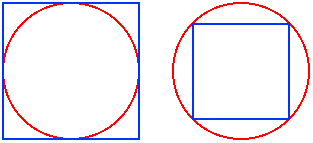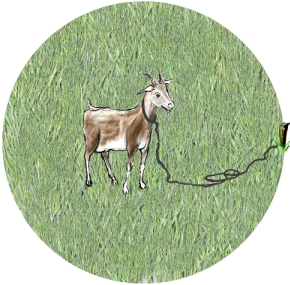Prof Jules has selected 5 challenging problems for you that will be solved using different methods. They are:
- Three-digit numbers (Arithmetic / pure maths)
A three-digit number is such that its second digit is the sum of its first and third digits.
Prove that the number must be divisible by 11.
- Rectangle triangle problem (Geometry)
You are given a rectangle OABC from which you remove three right-angled triangles leaving a fourth triangle OPQ as shown in the diagram below.

How must you position the points P and Q so that the area of each of the three removed triangles is the same? That is, what are the ratios AP:PB and CQ:QB?
- Mathematical Misfits (Geometry - Topology)
The two-dimensional puzzle
Which fits best - a square peg in a round hole, or a round peg in a square hole?

Which fits best?
- The Gobbling Goat (Applied Math)

Half Rations
This issue's PASS Maths puzzle is an old favourite. To work out the answer you might end up with an equation you can't solve: but it's fine to use a calculator to give you an approximate solution if you like.
A grassy field is in the shape of a circle of radius 100m and is enclosed by a circular fence.
A goat is attached by a rope to a hook, at a fixed point on the fence.
To stop the goat getting too fat, the farmer wants to make sure that it can only reach half of the grass in the field.
How long should the rope be?
- Puzzle - birth dates (Arithmetic / pure maths)
On John's 21st birthday his mother's age is 39. John adds the digits of his mother's age to get 3+9 = 12. He then repeats this process to get 1+2 = 3. Once he gets to a single digit he stops. He applies exactly the same process to his own age and gets 3 again.
He repeats this calculation for his next birthday, the birthday after that and so on. To his amazement, repeatedly adding the digits of his mother's age always gives the same value as repeatedly adding the digits of his own age. It seems that he and his mother share a special numerical relationship.
John then investigates whether he shares this numerical relationship with his father. On John's 21st birthday his father's age is 46. Adding the digits gives 4+6 = 10 and adding again gives 1+0 = 1. Alas not! Furthermore, he discovers that he never does.
This age relationship between parent and child is not uncommon. What property must the parent's age have on the day the child is born if they are to share this numerical relationship?
Acknowledgement
These wording of these problems and the images are from https://plus.maths.org/
|